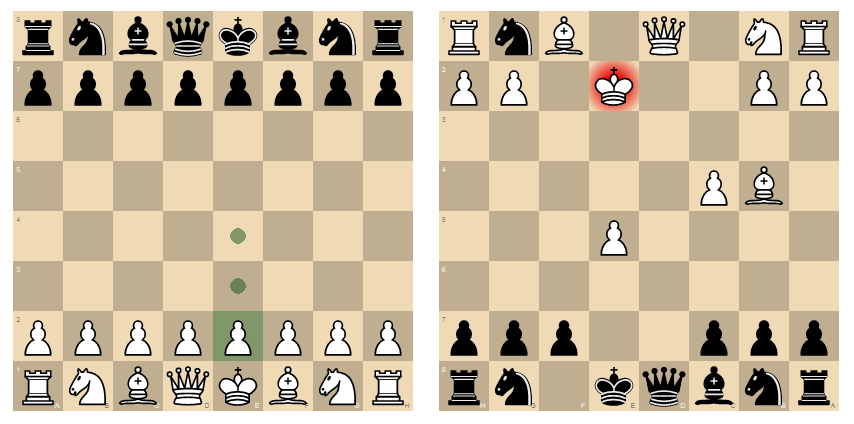Svelte-chess: Playable chess component
Fully playable chess component for Svelte. Powered by Chess.js logic, Chessground chessboard and optionally Stockfish chess AI.
Features
- Track game state via props or detailed events
- Play against Stockfish
- Undo moves
- Pawn promotion dialog
- Fully restylable
- Move history
- Typed
Usage
Installation:
npm install svelte-chess
Basic playable chessboard (REPL):
<script>
import {Chess} from 'svelte-chess';
</script>
<Chess />
Interact with the game via props, methods or events.
Props
Game state can be observed by binding to props.
| Prop | Bindable and readable | Writable | Value |
|---|---|---|---|
turn |
✓ | Current color to move: w or b |
|
moveNumber |
✓ | Current move number (whole moves) | |
history |
✓ | Array of all moves as SAN strings, e.g. ['d4','Nf6'] |
|
inCheck |
✓ | True if the player to move is in check. | |
isGameOver |
✓ | True if the game is over. See also the gameOver event. | |
fen |
✓ | ✓ | Current position in FEN |
orientation |
✓ | ✓ | Orientation of the board: w or b. |
engine |
✓ | Options for the Stockfish chess AI. See Engine. | |
class |
✓ | CSS class applied to children instead of default (see Styling). |
All readable props are bindable and updated whenever the game state changes. Writable props are only used when the component is created.
Example using bindable props to monitor state (REPL):
<script>
import {Chess} from 'svelte-chess';
let moveNumber, turn, history;
</script>
<Chess bind:moveNumber bind:turn bind:history/>
<p>
It's move {moveNumber}, with {turn} to move.
Moves played: {history?.join(' ')}.
</p>
Starting from a specific FEN (REPL):
<Chess fen="rnbqkb1r/1p2pppp/p2p1n2/8/3NP3/2N5/PPP2PPP/R1BQKB1R w KQkq - 0 6" />
Methods
The board state can be read and manipulated via method calls to the Chess component itself.
Methods for reading game/board state:
getHistory(): Same as thehistoryprop. All moves played in the game, as an array of SAN strings, e.g.['d4','Nf6','Bg5'].getHistory({verbose: true}): All moves played in the game, as an array of Move objects.getBoard(): An 8x8 array of the current position. Each element is null (empty square) or an object on the form{ square: 'd8', type: 'q', color: 'b' }.
Methods for manipulating game/board state:
move( san ): Make a move programmatically. Argument is the move in short algebraic notation, e.g.Nf3. Throws an error if the move is illegal or malformed.load( fen ): Loads a position from FEN. Throws an error if the FEN could not be parsed.reset(): Resets the game to the initial position.undo(): Undoes the last move and returns it.toggleOrientation(): Flips the board.makeEngineMove(): Make the best move according to the engine. See Engine / Stockfish for loading the engine.
Example implementing undo/reset buttons (REPL):
<script>
import {Chess} from 'svelte-chess';
let chess;
</script>
<Chess bind:this={chess}/>
<button on:click={()=>chess?.reset()}>Reset</button>
<button on:click={()=>chess?.undo()}>Undo</button>
Events
A ready event is dispatched when the Chess component is ready for interaction,
which is generally immediately on mount. If an engine was
specified, the event is dispatched after engine initialisation, which might take
a second.
A move event is dispatched after every move, containing the corresponding Move object.
A gameOver event is emitted after a move that ends the game. The GameOver object has two keys:
reason:checkmate,stalemate,repetition,insufficient materialorfifty-move rule.result: 1 for White win, 0 for Black win, or 0.5 for a draw.
A uci event is emitted when Stockfish, if enabled, sends a UCI message.
Example listening for move and gameOver events (REPL):
<script>
import {Chess} from 'svelte-chess';
function moveListener(event) {
const move = event.detail;
console.log( `${move.color} played ${move.san}` );
}
function gameOverListener(event) {
console.log( `The game ended due to ${event.detail.reason}` );
}
</script>
<Chess on:move={moveListener} on:gameOver={gameOverListener} />
Svelte-chess exports the MoveEvent, GameOverEvent, ReadyEvent and UciEvent types.
Engine / Stockfish
Svelte-chess can be used to play against the chess AI Stockfish 14. You need to download the Stockfish web worker script separately: stockfish.js web worker (1.6MB) and serve it at /stockfish.js. If you're using SvelteKit, do this by putting it in the static folder.
Example playing Black versus Stockfish (live):
<script>
import Chess, { Engine } from 'svelte-chess';
// Note: stockfish.js must be manually downloaded (see Readme)
</script>
<Chess engine={new Engine({depth: 20, moveTime: 1500, color: 'w'})} />
The engine prop is an object with the following keys, all optional:
| Key | Default | Description |
|---|---|---|
color |
b |
Color the engine plays: w or b, or both for an engine-vs-engine game, or none if the engine should only make a move when makeEngineMove() is called. |
moveTime |
2000 | Max time in milliseconds for the engine to spend on a move. |
depth |
40 | Max depth in ply for the engine to search. |
To inspect Stockfish's current evaluation and other engine details, you can listen to uci events from the Chess component to read all UCI messages sent by Stockfish.
Styling
The stylesheet shipped with Chessground is used by default. To restyle the
board, pass the class prop and import a stylesheet.
Example with custom stylesheet:
<script>
import { Chess } from 'svelte-chess';
</script>
<link rel="stylesheet" href="/my-style.css" />
<Chess class="my-class" />
A sample stylesheet can be found in /static/style-paper.css.
Types
Move
A Move describes a chess move. Properties:
color:wfor White move orbfor Black move.fromandto: Origin and destination squares, e.g.g1andf3.piece: Piece symbol, one ofpnbrqk(pawn, knight, bishop, rook, queen, king).capturedandpromotion: Piece symbol of a capture or promotion, if applicable.san: Standard algebraic notation, e.g.Nf3.lan: Long algebraic notation, e.g.g1f3.beforeandafter: FEN of positions before and after the move.flags: String of letters for each flag that applies to the move:cfor standard capture,efor en passant capture,nfor non-capture,bfor two-square pawn move,pfor promotion,kfor kingside castling andqfor queenside castling.check: True if the move put the opponent in check (or checkmate).checkmate: True if the move put the opponent in checkmate.
Future
- Programmatically draw arrows/circles on the board
